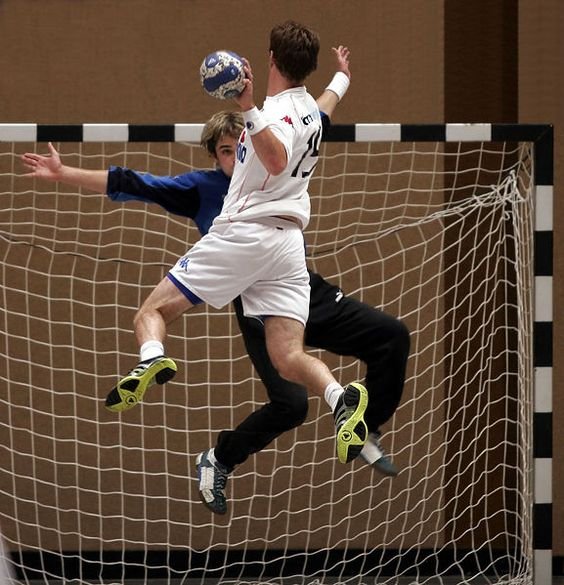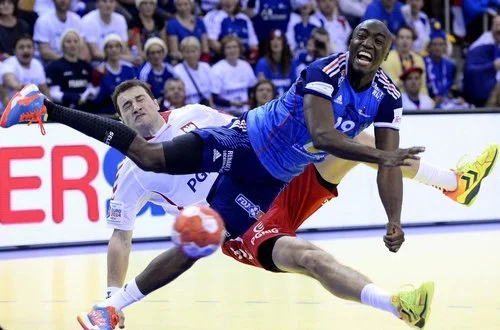Know the Game: A Guide to Handball
Everything You Need to Know About the Game of Handball
Handball, sometimes called team handball or Olympic handball, has featured in every Summer Olympics since 1972.
It is the second-biggest sport in Europe in terms of participation and viewing figures, behind football.
Handball also ranks second behind ice hockey in the list of fastest team sports!
Yet, in much of the English-speaking world, the sport has never received a lot of traction. It is still considered a minority sport among those who have at least heard of it.
However, that is beginning to change in places like the United Kingdom, where the legacy of the 2012 Olympics has seen the growth of the sport at rapid rates.
Handball is experiencing growth in the United States, too. The US are trying their best to create a competitive handball team by the time they host the 2028 Olympics in Los Angeles.
In this article, get to know the game of handball, including a guide to handball positions, rules, history and players.
What is Handball?
If you cannot picture the sport of handball, then imagine playing futsal with your hands, rather than your feet.
The court is almost identical, and the goals are exactly the same.
If that comparison is also lost on you, then let’s break it down.
Handball is a game played by teams of seven players - made up of six court players and one goalkeeper - and the object of the game is simple: to score more goals than your opponents.
It is played indoors on a 40x20m court, and a match is split into halves of 30 minutes.
At either end of the court is a two-metre high, three-metre wide goal that you have got to score into, and each goal is worth one point.
Men play with a size three ball, while women use a size two.
This is simply because you throw a handball with one hand, and a size three is too difficult for the average female hand to comfortably control.
Handball is high-scoring, with many games seeing a goal scored every minute.
A 30-30 draw is a typical score, but a low-scoring game of 19-18 can be much more exciting than a 41-39 scoreline!
How Do You Play Handball?
So, can you just run with the ball in your hands, straight into the goal?
No, sorry.
Each time a player is in possession, they are limited to taking three steps with the ball in their hands. If they want to travel further, they must dribble the ball by bouncing it, similar to basketball.
It is often more effective to move the ball quickly down the court by passing it.
Passes can be made in any direction and there are no limits to where a player can move on the court, with one exception.
The exception is that only the goalkeeper can enter the six-metre area that surrounds their goal.
However, when a player shoots, they are allowed to jump forward into the area but they must release the ball before they land.
Therefore, players can often be only two or three metres from the goal when they shoot, making the job of the goalkeeper that much harder!
Defenders are not allowed to defend inside their own area, nor are they allowed to steal the ball from an opponent’s hands.
The most effective way to defend is for all six court players to spread themselves around the edges of the area to block shots and intercept passes.
As the attackers are not allowed to barge their way through defenders, like in rugby or American football, the team in possession will regularly pass from side to side and make clever switches in order to open gaps within the defensive setup.
Handball: Suits tall people
Fouls
What surprises many first-time viewers is that handball is a contact sport.
Grabbing an opponent and wrapping two hands around them to stop their attack is perfectly legal, providing you make contact from in front of them.
No contact from the side or behind is allowed.
The most common fouls include defending inside the area, attacker fouls and contacts from behind.
Fouls are punished by a free throw or a seven-metre penalty shot. Yellow cards are seen as warnings before a two-minute suspension, where a player is sin-binned.
A dashed nine-metre line is also marked on the court, which is mainly used for free throws and tactical reasons.
Three two-minute suspensions for the same player result in a red card, but particularly bad fouls are punished with a straight red.
The very worst fouls will result in a blue card and a heavy suspension for the guilty player.
There is no shot clock in handball, but teams are punished for not attacking.
If the two referees believe the team in possession is not making enough effort to work a shooting opportunity, they will raise one hand.
From this moment, the team has a maximum of six passes to use before they must shoot.
With elements of basketball, football and rugby, handball really is the ultimate team sport.
Handball positions
Goalkeeper
Pretty straightforward!
A goalkeeper’s job is to protect the goal. Goalkeepers are not limited to their area, they can roam up the court if they so desire and goals by ‘keepers are much more common than in football or ice hockey.
If a goalkeeper has saved more than 30% of the shots they’ve faced, then they’ve had a good day.
They can also go 55 minutes watching balls fly past them, before making one or two crucial saves in the last minute and being the hero!
Centre
Also called the playmaker, the centre is usually the brains of the attack.
Their job is to start the attacks and decide which move the offence will use to work a shooting opportunity.
They are handball’s answer to a deep-lying midfielder or a quarterback.
Left & Right Back
Flanking the centre are the two back players.
Usually the tallest players, they are often the most powerful shooters on the team and responsible for the bulk of the goal-scoring.
Left & Right Wings
The wings can be found on the extremes of the court, and will often be the most eye-catching player on the court thanks to some graceful shooting.
In attack, they will often receive the ball right in the corner of the court, take their three steps infield and away from the goal, before jumping towards the centre of the court to open up as wide an angle as possible to shoot.
Top wings can use flicks of the wrist or fingertips to spin the ball past helpless goalkeepers.
For wings and backs, it is more useful to have right-handed players playing on the left, and left-handers on the right, keeping the shooting hand nearer to the centre of the court and creating a better shooting angle.
Pivot
Pivot players are sometimes called the line-player, as they tend to spend their time close to the six-metre line, among the opposing defence.
These players are often strong and stocky and their role is to disrupt the defence, open up space for teammates and provide another outlet for shooting.
Defensive specialists
This is not a position as such, but some players are so much better at defending than attacking that they are only used out of possession.
As handball has roll-on/roll-off substitutions, the defensive specialist can be swapped for an attacker whenever the ball changes hands.
The History of handball
Sports that involve throwing something resembling a ball existed throughout the ancient world, including in Greece and Rome, but even the modern version of handball is disputed.
Both Denmark and Germany claim to have invented the sport around the turn of the 20th century.
In Denmark, the tale goes that a Danish gym teacher invented the game to stop children from breaking windows with their footballs.
However, the first set of agreed-upon rules were published in Berlin in 1917.
Until the middle of the 20th century, it was an outdoor sport, played on a football pitch, with eleven players on each team.
This version of the sport was played in the 1936 Berlin Olympics, but two years later, also in Berlin, the first World Handball Championships were played indoors.
The outdoor version, now referred to as field handball, continued to decrease in popularity as the indoor version grew.
Handball returned to the Olympics in 1972 in Munich as an indoor sport, and it has remained part of the Summer Olympic programme ever since.
Which Countries Play Handball?
Handball is played in all corners of the world; the International Handball Federation currently has 209 members.
Europe is the heartland of the sport. Top players from Scandinavia, Germany, France, Spain, the Balkans and the former Soviet Union are household names.
Every Men’s World Championship and Olympic gold medal has been won by a European team.
That is not to say that the sport is exclusively European.
On the women’s side, South Korea has broken the European monopoly at the world and Olympic levels, while across both genders North Africa and the Middle East are hotbeds of the sport.
Handball is also very popular in Malaysia.
In the Americas, Brazil and Argentina have regularly led the way, though the likes of Greenland, Uruguay and the United States have had their moments in the sun.
What are the Biggest Handball Leagues and Tournaments?
Along with the World Championship and the Olympics, the European Championship makes up the trio of top international handball tournaments.
The men’s worlds and Euros are played after New Year, while the women’s equivalents take place before Christmas.
At the club level, the EHF Champions League is the showpiece tournament, running throughout the season and climaxing with the EHF Final4 events.
During these events, 20,000 handball fans pack the Lanxess Arena in Cologne for the men’s semi-finals and final.
The top handball players in the world feature very recognisable clubs such as FC Barcelona, Paris Saint-Germain and FC Porto.
The German Bundesliga is, for many, the best domestic league, while the French, Spanish, Hungarian and Danish leagues are also filled with quality players.
Watch Handball, You’ll Be Impressed!
60 minutes of end-to-end action, with speed, skill, spectacular goals and stunning saves constantly on the menu, it’s time to feast your eyes on the dramatic game of handball!








